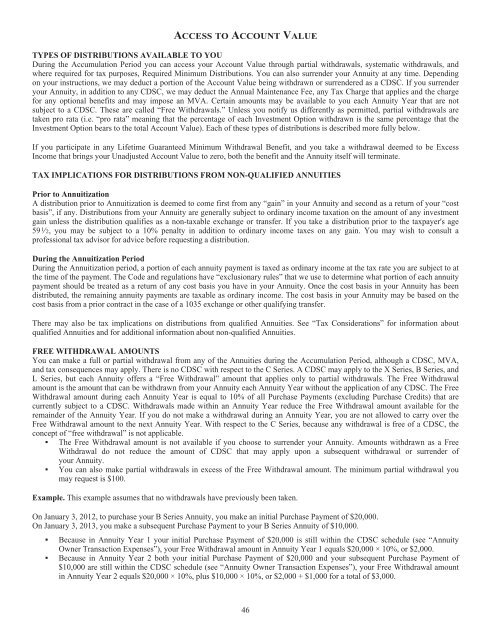Prudential Premier Retirement Variable Annuities
Prudential Premier Retirement Variable Annuities
Prudential Premier Retirement Variable Annuities
You also want an ePaper? Increase the reach of your titles
YUMPU automatically turns print PDFs into web optimized ePapers that Google loves.
ACCESS TO ACCOUNT VALUE<br />
TYPES OF DISTRIBUTIONS AVAILABLE TO YOU<br />
During the Accumulation Period you can access your Account Value through partial withdrawals, systematic withdrawals, and<br />
where required for tax purposes, Required Minimum Distributions. You can also surrender your Annuity at any time. Depending<br />
on your instructions, we may deduct a portion of the Account Value being withdrawn or surrendered as a CDSC. If you surrender<br />
your Annuity, in addition to any CDSC, we may deduct the Annual Maintenance Fee, any Tax Charge that applies and the charge<br />
for any optional benefits and may impose an MVA. Certain amounts may be available to you each Annuity Year that are not<br />
subject to a CDSC. These are called “Free Withdrawals.” Unless you notify us differently as permitted, partial withdrawals are<br />
taken pro rata (i.e. “pro rata” meaning that the percentage of each Investment Option withdrawn is the same percentage that the<br />
Investment Option bears to the total Account Value). Each of these types of distributions is described more fully below.<br />
If you participate in any Lifetime Guaranteed Minimum Withdrawal Benefit, and you take a withdrawal deemed to be Excess<br />
Income that brings your Unadjusted Account Value to zero, both the benefit and the Annuity itself will terminate.<br />
TAX IMPLICATIONS FOR DISTRIBUTIONS FROM NON-QUALIFIED ANNUITIES<br />
Prior to Annuitization<br />
A distribution prior to Annuitization is deemed to come first from any “gain” in your Annuity and second as a return of your “cost<br />
basis”, if any. Distributions from your Annuity are generally subject to ordinary income taxation on the amount of any investment<br />
gain unless the distribution qualifies as a non-taxable exchange or transfer. If you take a distribution prior to the taxpayer's age<br />
59 1 ⁄2, you may be subject to a 10% penalty in addition to ordinary income taxes on any gain. You may wish to consult a<br />
professional tax advisor for advice before requesting a distribution.<br />
During the Annuitization Period<br />
During the Annuitization period, a portion of each annuity payment is taxed as ordinary income at the tax rate you are subject to at<br />
the time of the payment. The Code and regulations have “exclusionary rules” that we use to determine what portion of each annuity<br />
payment should be treated as a return of any cost basis you have in your Annuity. Once the cost basis in your Annuity has been<br />
distributed, the remaining annuity payments are taxable as ordinary income. The cost basis in your Annuity may be based on the<br />
cost basis from a prior contract in the case of a 1035 exchange or other qualifying transfer.<br />
There may also be tax implications on distributions from qualified <strong>Annuities</strong>. See “Tax Considerations” for information about<br />
qualified <strong>Annuities</strong> and for additional information about non-qualified <strong>Annuities</strong>.<br />
FREE WITHDRAWAL AMOUNTS<br />
You can make a full or partial withdrawal from any of the <strong>Annuities</strong> during the Accumulation Period, although a CDSC, MVA,<br />
and tax consequences may apply. There is no CDSC with respect to the C Series. A CDSC may apply to the X Series, B Series, and<br />
L Series, but each Annuity offers a “Free Withdrawal” amount that applies only to partial withdrawals. The Free Withdrawal<br />
amount is the amount that can be withdrawn from your Annuity each Annuity Year without the application of any CDSC. The Free<br />
Withdrawal amount during each Annuity Year is equal to 10% of all Purchase Payments (excluding Purchase Credits) that are<br />
currently subject to a CDSC. Withdrawals made within an Annuity Year reduce the Free Withdrawal amount available for the<br />
remainder of the Annuity Year. If you do not make a withdrawal during an Annuity Year, you are not allowed to carry over the<br />
Free Withdrawal amount to the next Annuity Year. With respect to the C Series, because any withdrawal is free of a CDSC, the<br />
concept of “free withdrawal” is not applicable.<br />
▪ The Free Withdrawal amount is not available if you choose to surrender your Annuity. Amounts withdrawn as a Free<br />
Withdrawal do not reduce the amount of CDSC that may apply upon a subsequent withdrawal or surrender of<br />
your Annuity.<br />
▪ You can also make partial withdrawals in excess of the Free Withdrawal amount. The minimum partial withdrawal you<br />
may request is $100.<br />
Example. This example assumes that no withdrawals have previously been taken.<br />
On January 3, 2012, to purchase your B Series Annuity, you make an initial Purchase Payment of $20,000.<br />
On January 3, 2013, you make a subsequent Purchase Payment to your B Series Annuity of $10,000.<br />
▪ Because in Annuity Year 1 your initial Purchase Payment of $20,000 is still within the CDSC schedule (see “Annuity<br />
Owner Transaction Expenses”), your Free Withdrawal amount in Annuity Year 1 equals $20,000 × 10%, or $2,000.<br />
▪ Because in Annuity Year 2 both your initial Purchase Payment of $20,000 and your subsequent Purchase Payment of<br />
$10,000 are still within the CDSC schedule (see “Annuity Owner Transaction Expenses”), your Free Withdrawal amount<br />
in Annuity Year 2 equals $20,000 × 10%, plus $10,000 × 10%, or $2,000 + $1,000 for a total of $3,000.<br />
46

















